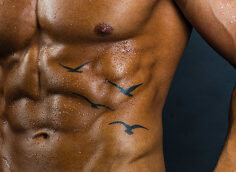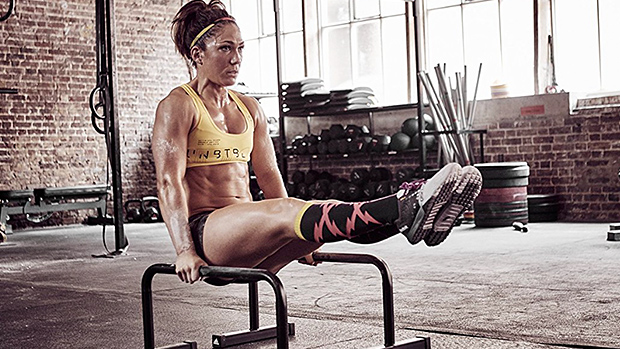The Standard Forward Lunge Sucks
The lunge is one of the six foundational movement patterns that every single person should be able to do. From a balance and proprioceptive standpoint, the staggered lower body stance challenges the hips, core, and shoulders to work together under loading. But let's set the record straight. When you see the word "lunge" don't just assume the alternating forward lunge is the only exercise at your disposal?

The truth is, the forward lunge is one of the most butchered exercises in the gym, and it has limited carryover into strength and hypertrophy (muscle gains). It also leads to more injuries than other lunge variations. There are better options.
The 4 Best Lunge Variations
Here are the four lunge variations that strengthen your legs while also bulletproofing your knees and lower back from chronic aches and pains in the process.
The reverse lunge involves a simple reverse step instead of the traditional forward step. Due to the change in torso angle, the reverse lunge creates more activation at the proximal hamstring and gluteal group and less compressive stress over the front side of the knees. These are all good things when your goal is to load up heavy and train for strength and size.
Coaching Notes: While smoothly stepping back under absolute control, your torso will have the tendency to flex forward, putting you into somewhat of a chest down position. As long as this flexion is coming from the hips and not the lower back, the change in angle can help recruit the glutes and hamstrings. Likewise, exploding back up into a neutral position and touching down with the foot to reset each rep keeps your focus on building strength, not balancing on one foot like a ballerina.
Common Mistakes: People have a tendency to speed up a movement that lacks dynamic stability. Many great athletes can tap into compensation patterns more effectively if a movement pattern is sped up, so you should slow yourself down and own your movements, especially in the reverse lunge.
One trick that enhances stability is the use of a packed neck position throughout the movement. It's been said that where the head goes, the body follows. That's why keeping your cervical spine in neutral alignment with the thoracic and lumbar region translates very nicely into crisp movements that create gains, not pains.
The split squat hammers in sound movement patterns while allowing your body to distribute forces and tension that create stability through the hips and core. The split squat requires both feet be kept on the ground, thus focusing on the motor control and stability. This movement only gets better with the addition of a front foot raised position, which can be a game changer for your quads and glutes.
Coaching Notes: The bane of most lifters who do lunges involves the lack of motor control and stability that's exacerbated when one leg is off the ground. Most lifters lack stability from not creating tension through the glutes and hamstrings before initiating the eccentric (lowering or negative) portion.
By adding a few inches of elevation under the front foot, the hams and glutes are pre-tension loaded so they have a better chance of creating stability via positional manipulation, in addition to being less dependent on volitional muscular recruitment and activation. The trick here is to gain tension in the posterior chain and work damn hard to maintain it throughout the duration of a set.
Common Mistakes: A common mistake is adding too much front foot elevation. With too high of front foot elevation, the available non-compensated range of motion is cut down to a minimum, which doesn't help grow the legs. Start with a plastic exercise step that's 2-4 inches tall and work up or down from there. When altering closed chain kinematics, a little goes a long way.
If your goal is to really own hip and core stability through single-leg stance variations, the forward/reverse lunge combo will provide a hell of a challenge, both from a coordination perspective and cardiovascular-based training effect. It should be noted that this is a progression from the forward or reverse lunges and not just another excuse to have your technique fall to shit under a heavy metabolic stressor. Have success, then progress.
Coaching Notes: Start off in a neutral position with your feet next to one another and then move into a forward lunge with the right leg. Then move directly into a reverse lunge on that same right leg. The same leg will remain dynamic throughout the entire set. Then, when all reps are completed, you switch to the other leg.
Common Mistake: The lack of tempo and rhythm is the most common mistake. In the athletic population, an athlete is usually considered either an anterior chain (quads) dominant athlete or a posterior chain (hip) dominant athlete. Rarely do I see an athlete that's perfectly balanced from front to back and is able to integrate posterior chain stability with dynamic actions of the anterior chain.
This means that you'll most likely have great rhythm on either the forward or reverse lunge portions of this movement, but not both. This will provide a challenge to maintain steady tempo of your eccentric and concentric phases of movement on each step.
Yeah, I know, it's more complicated than it looks. To help enhance this rhythm, keep a counting tempo in your head with a 2-second eccentric on the forward or reverse lunge and a 1-second explosive transition back to a neutral position.
Also called the Bulgarian split squat, this exercise has the ability to create loads of recruitment and tension through the quads and glutes and have you gasping for air after just a few reps when you start to load up properly.
Coaching Notes: By using an elevated surface like a weight bench, you can create the setup that will achieve the most spinal-friendly lower body pump of your life. If you can, grab a power rack and set up a bar at approximately the height of the bench, which can be a little more comfortable on the foot, and let the ankle remain in a neutral position with the toe placed facing down.
Using dumbbells, drop down under control into the eccentric portion of the lift and achieve as deep of a hip flexed position as possible without compensating on the back side of your pelvis with spinal rounding. Increasing the concentric contraction speed on the way up can also target the quads and glutes in a more novel fashion.
Add a split second hold at the top of every rep just to ensure that tension is placed through the lower glutes and proximal hamstrings before you start the dynamic component of the lift. Remember, stability is an absolute requisite here.
Common Mistakes: This movement can be one hell of a stability challenge, even when executed with bodyweight only. However, if your goal is muscular size and strength, you can't rely only on bodyweight. You've got to load it up.
To ensure stability, you can place a hand on a power rack while you load the other hand with a dumbbell. Though I consider this a regression from the free-standing rear foot elevated split squat, the training effect feels like anything but a simplified version of the movement.
Due to having taken instability out of the equation, you can create greater tension through the quads, hamstrings, and glutes. This will have your legs burning under even some of the most unassuming loads. In the video, note the isometric holds between each drop.





